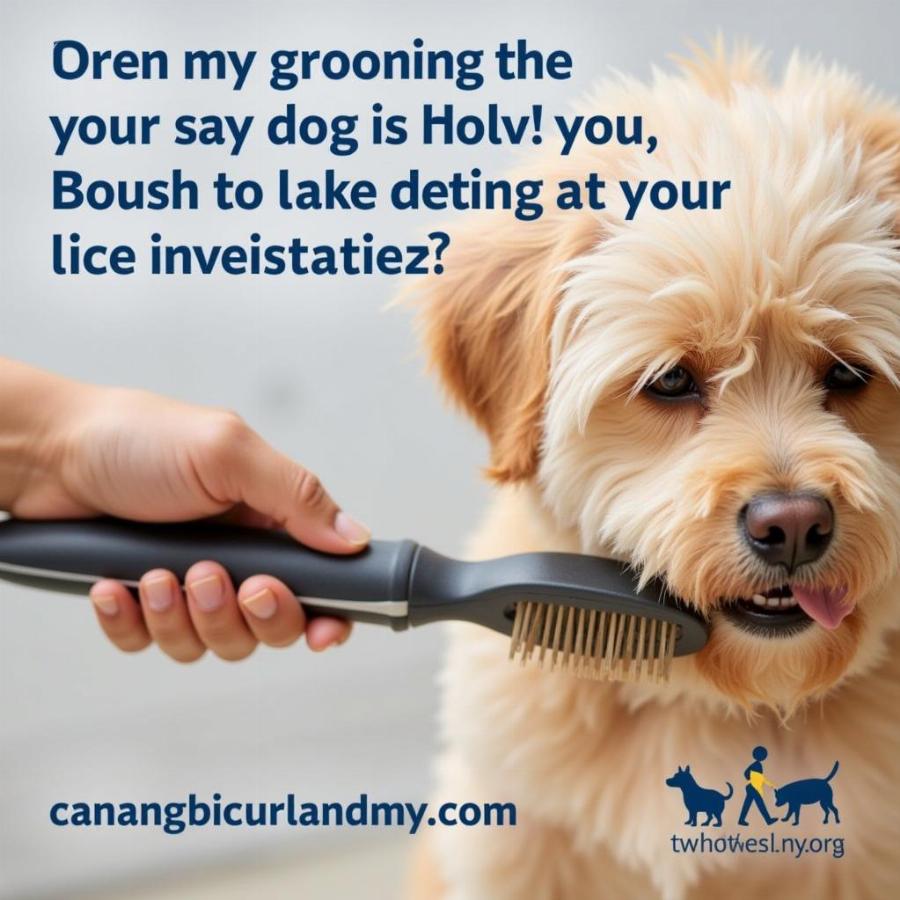Dog lice are a common nuisance for our furry friends, but the question many pet owners have is, “Can dog lice get on humans?” The short answer is no, they can’t. While seeing your dog scratch and itch can be concerning, you don’t have to worry about these tiny pests taking up residence on your head or body. This article will delve into the specifics of dog lice, explaining why they are species-specific and what you should do if your canine companion is infested.
Understanding Dog Lice: Species-Specific Pests
Dog lice are tiny, wingless insects that live on the skin and hair of dogs. There are two main types: Trichodectes canis, the biting louse, and Linognathus setosus, the sucking louse. Both types feed on your dog’s skin debris and blood, respectively, causing irritation and itching. Importantly, these lice are species-specific, meaning they can only survive on dogs. Human lice, on the other hand, are adapted to live on humans and cannot survive on dogs. This biological distinction is crucial in understanding why you won’t get dog lice. Just as human lice can’t infest your dog, dog lice can’t infest you.
Why You Won’t Get Dog Lice: Biological Barriers
The reason dog lice can’t live on humans is down to their evolutionary adaptations. Lice have evolved to thrive in specific environments, including the body temperature, skin pH, and hair type of their host. Human skin and hair are significantly different from a dog’s. Our body temperature, skin composition, and hair texture are simply not suitable for dog lice to survive and reproduce. They would quickly dehydrate and die. So, even if a dog louse were to momentarily crawl onto you, it wouldn’t be able to establish an infestation. Think of it like trying to plant a tropical flower in a snowy climate – it simply won’t thrive.
What to Do if Your Dog Has Lice: Treatment and Prevention
If your dog is exhibiting excessive scratching, itching, or hair loss, it’s essential to check for lice. Look closely at their fur, particularly around the ears, neck, and tail. You may see the lice themselves or their eggs (nits), which appear as small, white or yellowish specks attached to the hair shafts. do dogs get nits discusses this further. If you suspect your dog has lice, consult a veterinarian. They can confirm the diagnosis and recommend appropriate treatment, which may include medicated shampoos, sprays, or oral medications. It’s crucial to follow their instructions carefully to ensure the complete eradication of the lice.
Preventing Dog Lice: Hygiene and Regular Checks
Preventing dog lice is easier than treating an infestation. Regular grooming, including bathing and brushing, can help remove lice and their eggs. Be sure to use a dog-specific shampoo and conditioner. Keep your dog’s bedding clean and wash it frequently in hot water. Also, avoid contact with other dogs that may be infested. Regularly inspect your dog’s fur, especially after they’ve been in contact with other animals. dog lice and humans can provide additional information on this topic.
 Dog being groomed with a brush
Dog being groomed with a brush
Conclusion: No Need to Worry About Catching Dog Lice
While dog lice are unpleasant for our canine companions, they pose no threat to humans. Their species-specific nature prevents them from infesting us. If your dog has lice, focus on getting them appropriate veterinary treatment and implementing preventative measures to keep these pests at bay. By understanding the biology of these tiny creatures, we can put our minds at ease and ensure our furry friends stay happy and healthy. maple bacon dog offers unrelated but interesting content. Remember, a healthy dog is a happy dog!
FAQ: Common Questions About Dog Lice
-
Can I get lice from my dog? No, dog lice are species-specific and cannot infest humans.
-
How do dogs get lice? Dogs typically get lice through direct contact with another infested dog.
-
What are the symptoms of dog lice? Excessive scratching, itching, hair loss, and visible lice or nits on the fur are common signs.
-
How are dog lice treated? Treatment usually involves medicated shampoos, sprays, or oral medications prescribed by a veterinarian.
-
Can I use human lice treatment on my dog? No, never use human lice treatment on a dog. Always consult a veterinarian for appropriate treatment options.
-
How can I prevent my dog from getting lice? Regular grooming, clean bedding, and avoiding contact with infested dogs can help prevent lice.
-
Are dog lice contagious to other pets? Dog lice are typically only contagious to other dogs. best weapon to defend against dog attack is an interesting read for dog owners.
Further Exploration
For more information on pet ownership and related legal aspects, you might find can animal control take my dog without a warrant a helpful resource.
About Beaut Dogs
Beaut Dogs is your one-stop resource for everything related to dog care, offering expert advice and in-depth knowledge about various breeds, health, nutrition, and training. We are committed to providing reliable information to help you give your canine companion the best possible care. When you need support, please contact Email: [email protected] to get detailed and accurate answers from Beaut Dogs. Visit https://beautdogs.com today to explore the wonderful world of dogs and learn how to care for them!